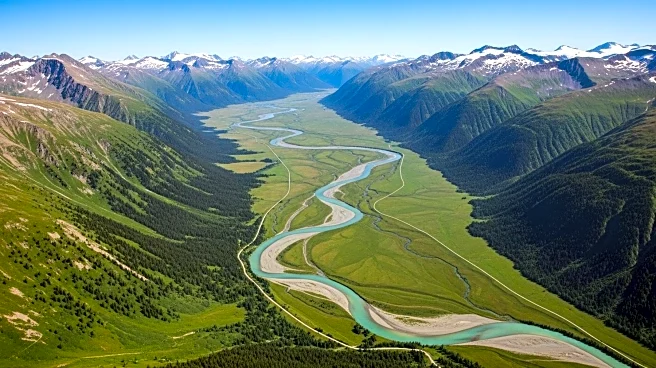What's Happening?
The Yarlung Zangbo River, recognized as the highest major river on Earth, is experiencing increasing instability due to climate change, according to NASA's Earth Observatory. Stretching approximately 1,250 miles from the Tibetan Plateau into India, the river is a classic example of a braided river, characterized by multiple channels that frequently change shape. This instability is primarily caused by heavy sediment deposits from the Himalayas, which are washed into the river, carving new channels. The river's dynamic nature prevents vegetation from growing on its sandbars, which are continuously formed and reformed. Satellite images from Landsat missions have documented these changes over decades, highlighting the river's shifting patterns. The river's origin at the Angsi Glacier has been confirmed, with significant meltwater contributing to sediment deposits, exacerbating erosion and bank collapse risks.
Why It's Important?
The instability of the Yarlung Zangbo River has significant implications for local ecosystems, infrastructure, and landscape stability. As climate change accelerates glacier melt, increased sediment deposits threaten the river's banks, posing risks to nearby communities and wildlife. The river's dynamic nature could lead to more frequent flooding and erosion, impacting agriculture and settlements along its course. Additionally, the river's changes could affect water availability and quality, crucial for the regions it traverses. Understanding these shifts is vital for developing strategies to mitigate climate change impacts and protect vulnerable areas.
What's Next?
Continued monitoring of the Yarlung Zangbo River is essential to assess the ongoing impacts of climate change. Researchers and policymakers may need to develop adaptive strategies to manage sediment flow and protect infrastructure. Collaborative efforts between China and India could be necessary to address cross-border water management challenges. Future studies might focus on predicting the river's behavior and implementing measures to safeguard affected communities and ecosystems.
Beyond the Headlines
The Yarlung Zangbo River's instability highlights broader environmental challenges posed by climate change, particularly in high-altitude regions. The river serves as a case study for understanding the complex interactions between glacial melt, sediment transport, and river dynamics. It underscores the need for international cooperation in addressing climate-related issues that transcend national boundaries. The river's changes also reflect the urgent need for sustainable environmental practices to mitigate climate impacts.











